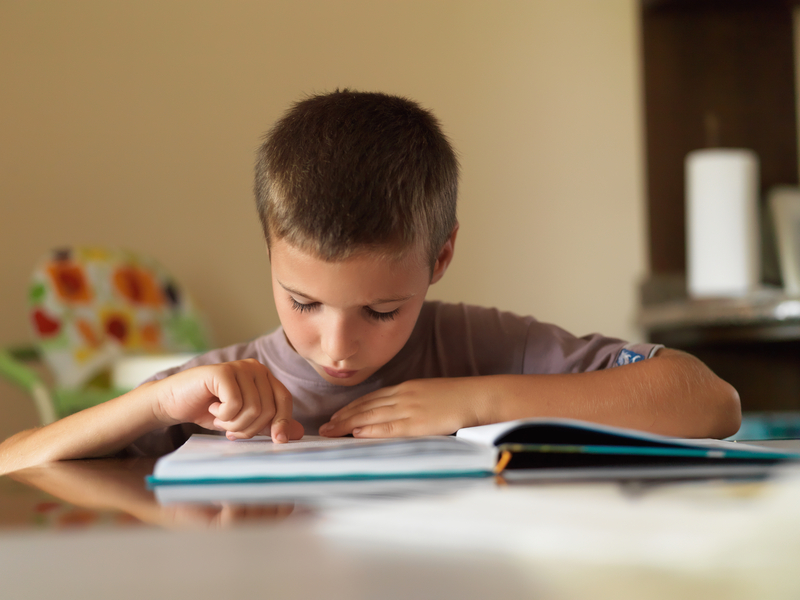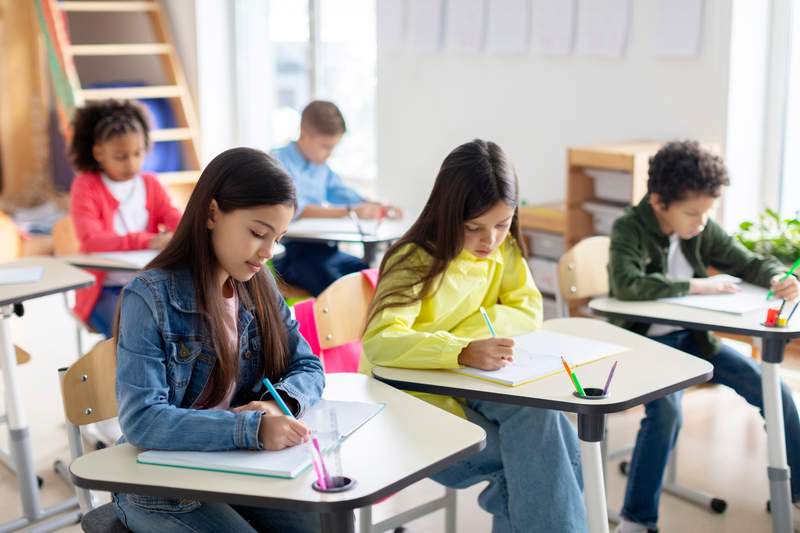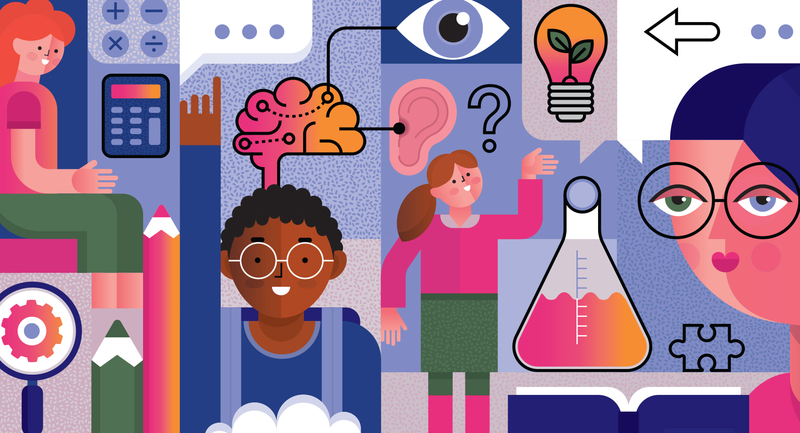Reading workshop is a beautiful structure for kids to "come of age" as readers and develop a lifelong love of reading. As instructors at Teachers College, where we lead workshops and institutes for thousands of teachers and school leaders each year, we have learned a lot about what makes reading workshop successful and what can make teachers anxious about teaching reading workshop. It's ambitious, hard work for a teacher to embrace. And yet we know from experience with children, teachers, schools, and districts that students will be profoundly changed by the autonomy and agency of reading workshop.
But there are some conditions that are needed for this format to work.
What Is Reading Workshop?
There are three main components to reading workshop. The first is a mini-lesson, where teachers take about 10 minutes to teach a reading strategy and engage students in actively trying it out in a shared text. After the mini-lesson, students engage in work time, which may involve reading (and writing about reading) in research clubs, book clubs, with a partner, or independently for approximately 30 minutes. Finally, near the end of workshop, students gather for a five to ten-minute shared reflection to consolidate their learning and to set goals, including for the reading they'll do that night outside of class.
In addition to these components, reading workshop is anchored by the interactive read-aloud experience, in which all students are engaged in high-level shared texts. During read-aloud, the teacher strategically introduces a series of analytical lenses, and students pause often to discuss their interpretation of the text with a partner. The teacher listens carefully to students' responses and gives feedback and tips. The read-aloud text is usually at or slightly above grade level, and some students may need extra support in the form of storyboards or other scaffolds.
In a reading workshop, the teacher is deeply engaged in teaching a curriculum emphasizing comprehension, interpretation, and critical literacy skills; in supporting students in reading a lot, both inside and outside of school; and in moving kids up levels of text complexity.
Reading workshop calls on teachers to love books and young people, to strive to see what students need as readers and as human beings, and to put aside their own sometimes deeply felt desire that kids should only focus on understanding one text deeply.
Critical Features
Now let's look at what conditions need to be met to make this practice most effective.
1. Kids need access to books they find fascinating.
In the article "Every Child, Every Day," Allington and Gabriel (2012) lay out six elements of effective reading instruction. Number one is: "Every child reads something he or she chooses" (p. 10). The authors state that "the research base on student-selected reading is robust and conclusive: Students read more, understand more, and are more likely to continue reading when they have the opportunity to choose what they read" (p. 10). Educator Donalyn Miller emphasizes this reciprocal relationship. Choice inspires reading. Reading influences choice. "When we diminish a child's reading choices," Miller states, "we diminish the child" (2017).
One reason that adults may fear choice is that the gritty realism of contemporary children's literature can be disturbing. The Harry Potter series and Children of Blood and Bone feature characters, including teens, who die. Children endure harsh bullying in Tiger Rising and The Misfits and racism in The Skin I'm In and Dear Martin. It's these serious books, though, that many young people are most drawn to and affected by. "Children explain that vicariously living through characters' dilemmas and weighing their options makes them consider how they are navigating their own present and future lives" (Ivey & Johnston, 2017, p. 160). That kind of transactional reading doesn't occur in a classroom where the teacher controls the text, where every student reads the same pages of the same book on the same day, inching through the text, finishing five or six books a year. Tatum (2005) warns that all too often, when teachers choose books that they love, some kids can go weeks and never encounter a text in school that feels relevant to the lives they are living.
2. Teachers need to curate libraries that foster student identities.
Kids need to see themselves in books in dynamic ways. When you have a single-novel curriculum, the teacher or school district's text becomes the curriculum. This is problematic because the text chosen (often a canonical book by a white author) can propagate stereotypes and victim narratives and marginalize or make invisible whole groups of people. Author Grace Lin addresses this in her video essay "What to Do When You Realize Classic Books from Your Childhood Are Racist" (2017).
In 2019, when Lin spoke at a principals' conference at Teachers College in New York, she reflected on her love of reading fantasy fiction as a young student. As a child of Taiwanese immigrants to the United States, she recalled that reading reinforced a strange relationship with her identity. "Even in fantasy, where the impossible could happen, I still did not exist," she said. African American author Jason Reynolds, who also spoke in 2019 at Teachers College, remembered saying to his teacher, "None of the books you ask me to read have anything to do with me." Both Lin and Reynolds spotlight the ways in which, when we limit the types of books we offer children, the curriculum can be identity-silencing.
For decades, multiculturalist educator Rudine Sims Bishop (1990) has underscored the importance of all children having access to books that serve as both mirrors and windows. All students, she asserts, deserve to see themselves reflected in the books they read, as well as to learn about the lives of those different from themselves. This is especially true in homogenous contexts where students might have less opportunity to hear from voices that have been underrepresented and marginalized.
In 2019, the Cooperative Children's Book Center at the University of Wisconsin reported its research on multicultural publishing statistics (Park, 2019), finding that books that feature white characters continue to dominate the children's publishing world. Further, books that do feature characters who are indigenous or of color should be read carefully, because sometimes books that seem to promote underrepresented characters are in fact affirming damaging stereotypes, or what Thomas (2019) calls racialized mirrors and windows.
It is critical, therefore, that educators curate culturally affirming classroom libraries. That means thinking about authorship, representation, and story lines. Simply having a lot of books isn't enough. Educators must reflect deeply about their own identities as well as their students, exploring how their own histories may shape the power dynamics of their classroom and the assumptions they make about students.
Children also need to develop robustly personal reading dynamics. We worry when we ask children to describe themselves as readers, and they say, "I'm a P reader," referring to their reading level, instead of, "I'm a fantasy reader, and I'm reading …." Classroom libraries, especially for young readers, should be organized in a way that makes it easy for students to reach for books they can read with fluency and comprehension. In a kindergarten classroom, it makes sense to have plenty of baskets labeled "A," "B," and so on, but there should also be baskets labeled "LOL" and "Wild Animals" and "Trucks"! As kids mature as readers, the classroom library can be organized by series, authors, and genres, and many categories should be created by kids.
3. Teachers need to provide every child with access to high-level curriculum and authentic texts.
A daunting challenge for educators is the need to make sure that every child has access to quality reading instruction. The Individuals with Disabilities Education Act made this a mandate when it was enacted in 1975, and the move toward national and state standards about a decade later heightened both the urgency and the challenge of that call. One of the most elegant answers to that challenge has come in the form of Universal Design for Learning (UDL), an instructional framework that emphasizes using a variety of teaching methods to give students as many ways as possible to access and succeed with high-quality curriculum. UDL not only works to offer access to students with a range of disabilities, but also to students who are emergent bilinguals, or come from diverse socioeconomic backgrounds, with a variety of life experiences, cultures, and identities.
The reading workshop structure is aligned with the UDL framework because, by design, it pivots from whole-class instruction (access to grade-level curriculum) to small group and conferences (differentiated and individualized instruction), with lots of opportunity for student agency and practice. Reading workshop teachers ensure that students have regular, spiraled exposure to grade-level skills, strategies, and texts through mini-lessons, read-alouds, and shared text experiences. Using their knowledge of their students either through classroom-based assessments, individualized education programs, or other means, they can then make choices for the types of group work that would best match each student's needs, goals, and abilities.
For example, workshop teachers do not need to heavily scaffold a grade-level textbook for a student who currently reads below benchmark, or offer "extra enrichment reading" for a child who read the whole-class text in two days. Instead, students choose and are guided to texts that match their current abilities—and with instruction, time spent reading, and a high volume of reading, they are also guided to tackle ever-more complex texts.
If a student needs time for intensive phonics instruction or to work on higher level comprehension skills, a teacher or service provider can work within the model to provide what the student needs through small groups and conferences. While this is especially crucial for students with identified learning disabilities, educators know that there are many kids who might benefit from additional scaffolds and tools.
4. Children need explicit phonics instruction in the primary grades.
In their guide to teaching phonics, Calkins and Louis (2018) remind teachers: "If you are the best reading and writing workshop teacher in the world, and yet do not teach your children phonics, that is not enough. If your children cannot get words onto and off the page, they will not write letters advocating for a class turtle, nor will they stay up late reading by flashlight" (p. 1).
Phonics has been a crucial part of reading workshop since its earliest days. Kids need regular, systematic, engaging, sequential phonics instruction. But more than that, systematic phonics instruction needs to be intentionally designed to authentically connect with plentiful opportunities to transfer those newly gained skills to engaging, rich texts. Phonics knowledge is necessary for decoding. The ability to decode with automaticity and fluency is paramount to comprehension, and students need a wealth of opportunities to practice reading. Reading workshop offers that practice.
When taught well, and in concert with screeners, observations, and assessments that might call attention to specific learning disabilities or needs, whole-class phonics instruction will eventually give way in upper grades to other sorts of word study. But older students may still benefit from phonics as well. If teachers know their students need phonics instruction in any grade, this should be a priority.
5. Kids need teachers who love books and love children equally.
In New York City's East Side Community High School, you'll find students reading dozens of books a year. The library is the heart of the school. Principal Mark Federman regularly leads principal-student book clubs and has built a culture of reading in his school by hiring readers. When Federman interviews prospective teachers, one of his questions is, "What are you reading?" This is because teachers who know, love, and deeply respect contemporary literature for young people end up knowing, loving, and deeply respecting their readers as well.
There is one more reason to nurture the teacher as reader. When classroom teachers have a rich and varied library, and know the books in it, then they can continually recommend books to readers. If a 5th grader starts the year reading Diary of a Wimpy Kid, or perhaps some of the Judy Blume novels, and finishes the year reading those same books, then that child started the year at grade level, but unfortunately will finish well below. It's tremendously important for students to have a teacher who can give them a progression of books and series in a genre they like, making it more likely that students make more strategic book choices and move up levels of text complexity.
Committing to What Matters Most for Readers
In Proust and the Squid, Wolfe (2008) illustrates how the brains of readers, when hooked up to an MRI, create new synapses while reading. Reading changes us, in enigmatic but tangible ways, especially through the creation of empathy. "The act of taking on the perspective and feelings of others is one of the most profound, insufficiently heralded contributions of the deep-reading processes," says Wolfe (p. 42). Bal and Veltkamp (2013) reiterate that the fictional narrative experience can "have an important and profound impact on how people feel and behave in their daily lives" (p. 1), but they also found that empathy was only built in readers when they experienced emotional transportation—the feeling of being lost in a book. When that happens, readers are transported to fictional worlds, where they experience the events of the story, the joys and anguish of characters, as real. That transportation, and its concurrent stirring of empathy, are more likely to happen when readers choose books that they find relevant and intriguing and they are embedded in a community which values reading.
It's true that one goal of reading workshop is to instill a repertoire of comprehension, decoding, and interpretation strategies, so that students handle the challenges of school, high-stakes tests, and career tasks with confidence and grace. But alongside that goal is another that cannot be tested on a state exam, but that can change kids' lives and the lives of those with whom they interact. That is for young people to become more empathetic, to gain insight into themselves and others, and to experience liberation in reading workshop through the books they choose to read.
Reflect & Discuss
➛ What do you see as the most necessary piece of a successful reading workshop?
➛ How important is it for children to see themselves in the books they read? Is this a consideration you make in your classroom?
➛ Do you agree with the authors that "kids need teachers who love books"? Why or why not?









